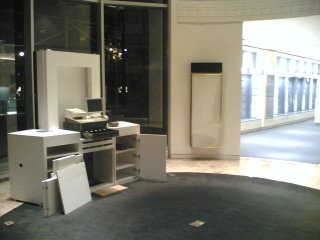A Death In The Family
 The only thing sadder than an empty school is an empty department store. One is accustomed to there being the hustle and bustle of humans going about their activities with a purposeful stride and a clear intent about them. There is supposed to be a “constant” about the place and when there is not, it’s just spooky.
The only thing sadder than an empty school is an empty department store. One is accustomed to there being the hustle and bustle of humans going about their activities with a purposeful stride and a clear intent about them. There is supposed to be a “constant” about the place and when there is not, it’s just spooky.Once upon a time, Lord & Taylor and Marshall Fields were owned by the The May Company. There is a long and storied history behind both of these name plates and their brief glancing relationship was not destined to be long lasting. L & T (1826) was the oldest department name in the country and Fields (1852) was famous throughout the country for its innovations and quality. The road to divorce and death is a long and ugly one.
Let me say first off that May was the Death Star of retail, few if any mourn their passing. I worked for some May stores, H & S Pogues, L.S. Ayres, L & T and it was never pretty. They were known throughout the business as being cheap and dirty stores full of crap merchandise. Even L & T suffered, though they were spared the worst. Everyone knew that May bought them to burnish their image. Polish it all you want, since the middle ages man has known that no matter how much you polish it, you can't turn brass into gold.
The management was mean and stingy, attracting low end employees who were treated badly. There was always a ‘sale” of one variety or another, I don’t know that I ever sold anything full priced, since the shoppers were accustomed to waiting for markdowns, coupons and clearances.
Drama mamas part one
May also tended to lurched from self induced crisis to self induced crisis, gobbling up heritage stores and groups like Associated Dry Goods ( Robinsons, Stewarts, Goldwaters, Stix Baer, Denver Dry Goods, Ayres, Horne, and Caldor) in 1986, killing off the nameplates, and with it any goodwill left for them, driving them into the ground. May sucked and working for them was like a gulag.
After May bought ADG, they renamed/merged most of the stores except L & T, one of the few wise moves they every made. However, May just didn’t get it and they paid the most extreme price, being gobbled up by Federated in 2005 in a massive land grab not seen since the Sears/K-Mart bloodbath.
Drama mamas part two
Federated Department Stores also had a storied heritage, though not without it’s own reckless, egregious and hubris-filled moments. In a stereotypically greed-is-good moment, they were merged with the Allied Stores group in 1988 by Robert Campeau (idiot Canadian real estate Trump wannabe) whereupon the entire shebang went belly up into bankruptcy in 1990, taking such brand names as Bonwitt, Jordan Marsh, Stern’s, Ann Taylor, Brooks Brothers, and my home town Mabley & Carew with them.. I was ever so lucky to be working there when the shit hit the fan.
Then they decided to buy Macy’s.
Macy’s bought itself out in 1986 and then duked it out with Campeau Corp (the bad guys) in 1988 for Federated, walking away with Bullocks, Bullocks Wilshire and I. Magnin for their troubles. Then in 1992 the ship sank with all hands aboard, and yet another heritage nameplate was in the courts, hat in hand. After a long and difficult courtship, R.H. Macy & Co. finally merged with Federated Department Stores on December 19, 1994
A brief visit.
Fields was sold by Dayton-Hudson (Target) to May when even they couldn’t make it work and decided to abandon the department store tradition and focus on the upscale end of the discount market. Target survived. Fields didn’t. With the Federated/May merger Fields had 3 owners in 2 years.
And so, for one brief shining moment, Fields and L & T, sister stores by marriages of convenience and connivance lived nestled next to each other at 835 N. Michigan Ave here in Chicago at The Watertower Place shopping center. Both had been original anchor tenants of this impressive and wildly successful retail reinvention, the “vertical shopping mall” in one of the grandest shopping districts in the United States.
Sadly it was not destined to be. Federated, which was busy tinkering with its own heritage nameplate stores like Lazarus, Bullocks, I Magnin, Rich’s, Foleys, Burdines, Abraham & Straus, Filene's and Bloomingdales decided to flush them all and call the whole thing Macy’s. While most May shoppers welcomed it, Fields shoppers are STILL bitching about it, and Macys had admitted their own misstep in the America’s #3 market. Oooops!
Hugging Goodbye.

Federated decided that there was no room in the family for L & T, and sold them off to a real estate group called NDRC Equity Partners, LLC
“June 22, 2006--Federated Department Stores, Inc. (NYSE:FD)(NYSE Arca:FD) today announced that it has signed an agreement to sell its New York-based Lord & Taylor division to NRDC Equity Partners, LLC for $1.195 billion in cash. NRDC Equity Partners, based in Purchase, NY, is a partnership between principals of Apollo Real Estate Advisors, L.P. and principals of National Realty & Development Corp.”
They bought it for the real estate.
And so, on March 27, 2007, they turned the lights off next door. Lord & Taylor, we’ll miss you. If it’s any consolation, “only the good die young.”


